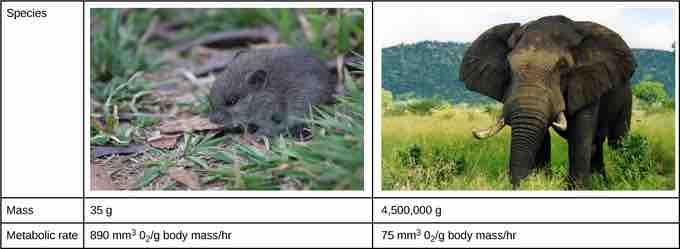Animal Bioenergetics
All animals must obtain their energy from food they ingest or absorb. These nutrients are converted to adenosine triphosphate (ATP) for short-term storage and use by all cells. Some animals store energy for slightly longer times as glycogen, while others store energy for much longer times in the form of triglycerides housed in specialized adipose tissues. No energy system is one hundred percent efficient as an animal's metabolism produces waste energy in the form of heat. If an animal can conserve that heat and maintain a relatively-constant body temperature, it is classified as a warm-blooded animal: an endotherm. The insulation used to conserve the body heat comes in the forms of fur, fat, or feathers. The absence of insulation in ectothermic animals increases their dependence on the environment for body heat.
The amount of energy expended by an animal over a specific time is called its metabolic rate. The rate is measured in joules, calories, or kilocalories (1000 calories). Carbohydrates and proteins contain about 4.5-5 kcal/g, while fat contains about 9 kcal/g. Metabolic rate is estimated as the basal metabolic rate (BMR) in endothermic animals at rest and as the standard metabolic rate (SMR) in ectotherms. Human males have a BMR of 1600-1800 kcal/day, and human females have a BMR of 1300 to 1500 kcal/day. Even with insulation, endothermal animals require extensive amounts of energy to maintain a constant body temperature. An ectotherm such as an alligator has an SMR of 60 kcal/day.
Energy Requirements Related to Body Size
Smaller endothermic animals have a greater surface area for their mass than larger ones . Therefore, smaller animals lose heat at a faster rate than larger animals and require more energy to maintain a constant internal temperature. This results in a smaller endothermic animal having a higher BMR, per body weight, than a larger endothermic animal.

Body size and metabolic rate
The mouse has a much higher metabolic rate than the elephant since it has greater surface area relative to mass.
Energy Requirements Related to Levels of Activity
The more active an animal is, the more energy is needed to maintain that activity and the higher its BMR or SMR. The average daily rate of energy consumption is about two to four times an animal's BMR or SMR. Humans are more sedentary than most animals and have an average daily rate of only 1.5 times the BMR. The diet of an endothermic animal is determined by its BMR.
Energy Requirements Related to Environment
Animals adapt to extremes of temperature or food availability through torpor. Torpor is a process that leads to a decrease in activity and metabolism, which allows animals to survive adverse conditions. Torpor can be used by animals for long periods. For example, animals can enter a state of hibernation during the winter months, which enables them to maintain a reduced body temperature. During hibernation, ground squirrels can achieve an abdominal temperature of 0° C (32° F), while a bear's internal temperature is maintained higher at about 37° C (99° F).
If torpor occurs during the summer months with high temperatures and little water, it is called estivation. Some desert animals estivate to survive the harshest months of the year. Torpor can occur on a daily basis; this is seen in bats and hummingbirds. While endothermy is limited in smaller animals by surface-to-volume ratio, some organisms can be smaller and still be endotherms because they employ daily torpor during the part of the day that is coldest. This allows them to conserve energy during the colder parts of the day when they consume more energy to maintain their body temperature.